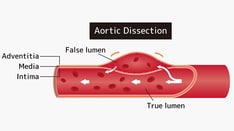Practice Essentials
Brown syndrome, in simplest terms, is characterized by restriction of the superior oblique trochlea-tendon complex [1] such that the affected eye does not elevate in adduction. Individuals with Brown syndrome may exhibit compensatory head turn or chin-up head posture and, occasionally, amblyopia. [2] The condition is usually unilateral but can be bilateral.
Congenital Brown syndrome is more common than acquired Brown syndrome. Congenital Brown syndrome can be associated with and possibly in the spectrum of congenital cranial dysinnervation disorders. Acquired causes of Brown syndrome include inflammation and trauma.
Background
In 1950, Harold W. Brown first published on an unusual motility disorder, characterized by the following: limited elevation in adduction; divergence in straight upgaze (V-pattern); same degree of limitation on versions, ductions, and forced ductions; widening of the palpebral fissure on adduction; normal or near normal elevation in abduction; restricted forced ductions to elevation in adduction; and compensatory chin elevation for binocular fusion.
Brown attributed the limited elevation to a short or tight anterior superior oblique tendon sheath. He termed this as superior oblique tendon sheath syndrome. The syndrome could be acquired or intermittent. In some cases, spontaneous resolution may occur. He further hypothesized that the short tendon sheath was due to a complete congenital paresis of the ipsilateral inferior oblique muscle and secondary to sheath contracture.
In the early 1970s, Brown redefined the sheath syndrome with the following divisions: true sheath syndrome characterized only those cases that have a congenital short anterior sheath of the superior oblique tendon, and simulated sheath syndrome characterized all cases with the clinical features of a sheath syndrome caused by an anomaly other than a congenital short anterior sheath of the superior oblique tendon. [3] Clinical features of true and simulated sheath syndromes were similar, but true sheath syndrome was always congenital and constant without spontaneous recovery.
In the mid-1970s, Parks and colleagues reported that a tight tendon sheath was not the cause of Brown syndrome; instead, it was a tight or short superior oblique tendon. [4] Subsequent studies confirmed the cause of the syndrome to be a tight or inelastic superior oblique tendon.
Pathophysiology
Brown syndrome can be differentiated into congenital and acquired, with congenital causes being more common. Congenital cases may represent a congenital cranial dysinnervation disorder. [5] With the exception of entities such as congenital cranial dysinnervation disorders, Brown "syndrome" may be a misnomer, if the problem is isolated to the eye. Notwithstanding as the term Brown "syndrome" is so entrenched, this article will not alter the terminology.
Congenital Brown syndrome
Superior oblique Brown syndrome
Superior oblique Brown syndrome or true Brown syndrome is restriction of eye movement up and adduction caused by an abnormal superior oblique muscle or tendon. As originally demonstrated by Brown, normal elevation of the eye into adduction increases the distance between the trochlea and the superior oblique insertion as the eye moves up and into adduction. A tight or inelastic superior oblique tendon muscle complex would restrict ocular elevation in adduction. Many theories for the cause of the tight or inelastic tendon exist.
Etiology of superior oblique Brown syndrome
Helveston theory of abnormal telescoping mechanism
Until recently, it was believed that the superior oblique tendon moves through the trochlea much like a rope through a pulley. Through a detailed anatomical study, Helveston showed that the tendon-slackening distal to the trochlea comes from a telescoping elongation of the central tendon. [6]
Telescoping elongation of the tendon is due to movement of the central tendon fibers, which have scant interfiber connections.
Congenital Brown syndrome could be caused by a developmental abnormality of the elastic-crossed fibers that normally allow the telescoping movement of the central tendon fibers.
Wright hypothesis of congenital inelastic superior oblique muscle-tendon complex
In 1999, Wright described a computer simulation of Brown syndrome, using two specific models, as follows: (1) a short superior oblique tendon, and (2) a stiff superior oblique tendon (stretched sensitivity). The computer model showed that a tight or inelastic muscle-tendon complex was the best fit for the Brown syndrome pattern of deviation.
The best simulation of Brown syndrome was obtained with 250% stretched sensitivity, producing a -4 limitation of elevation in adduction and a -1 limitation of elevation in abduction. With this simulation of a stiff superior oblique muscle-tendon complex, there was a very small deviation in primary position and no deviation in downgaze, which is consistent with the clinical findings of Brown syndrome.
Shortening the tendon from 32 mm to 28 mm did not significantly limit the elevation in adduction; however, shortening the tendon to 22 mm created a -4 limitation of elevation in adduction. Shortening the tendon to 22 mm also caused a hypotropia of 11 prism diopters (PD) in primary position and a hypotropia of 7 PD in downgaze, which is inconsistent with the classic clinical findings of Brown syndrome, where the deviation in primary position is very small to nonexistent and there is no hypotropia in downgaze.
Thus, the best computer model for Brown syndrome is a stiff or inelastic muscle-tendon complex. Perhaps, congenital Brown syndrome is a form of congenital fibrosis of the superior oblique muscle, which results in a stiff or inelastic muscle-tendon complex. [7]
Nonsuperior oblique Brown syndrome
Nonsuperior oblique Brown syndrome or pseudo-Brown syndrome is a restriction of ocular elevation in adduction caused by pathology other than an abnormality of the superior oblique muscle or tendon.
Etiology of congenital nonsuperior oblique Brown syndrome
Congenital bands: Inferior orbital fibrous adhesions or fibrous bands to the posterior globe are rare causes of restriction of elevation in adduction.
Congenital inferior location of lateral rectus muscle pulley: Rare case of congenital Brown syndrome are caused by congenital inferior location of the lateral rectus muscle. In these cases, the limitation of elevation in adduction is caused by the stiff lateral rectus muscle that is congenitally located inferior to the normal position. [8]
Acquired Brown syndrome
Acquired superior oblique Brown syndrome
See Causes.
Etiology of acquired superior oblique Brown Syndrome
Abnormal telescoping mechanism
In constant or intermittent acquired Brown syndrome, reduced telescoping elongation of the superior oblique tendon would be due to one of the following: vascular dilatation of the tendon sheath vessels and local edema occurring within the confined area of the trochlea.
Tight or inelastic superior oblique tendon
A tight superior oblique tendon can be caused by a mass that displaces the tendon, a scleral buckling, or a superior oblique tendon tuck.
A rare acquired fibrosis of the superior oblique muscle is possibly associated with thyroid disease, an intramuscular injection of local anesthetic, or Hurler-Scheie syndrome.
Acquired short tendon
This condition could be caused by a superior oblique tendon tuck, a mass that displaces the tendon, or a scleral buckling.
Superior oblique click syndrome
This theory has been used to explain acquired Brown syndrome that is associated with inflammatory conditions.
Inflammation produces a nodule on the superior oblique tendon, just posterior to the trochlea. The nodule would have difficulty entering the trochlea, thus restricting tendon movement.
Stenosing tenosynovitis (trigger-thumb analogy theory)
Chronic movement of the superior oblique tendon through the trochlea can result in a traumatic tenosynovitis with tendon-swelling and stenosis of the surrounding tendon sheath.
Trigger-thumb is a congenital or acquired constriction or stenosis of the fibrous sheath, which surrounds the tendon and causes secondary enlargement of the tendon proximal to the constriction.
The combination of a sheath-stenosis and tendon swelling prevents movements of the tendon.
Peritrochlear scarring
Scarring or fibrosis around the trochlea and the anterior superior oblique tendon would restrict the tendon movement, causing Brown syndrome.
Extensive scarring around the trochlea can result in restriction of the tendon movement in both ways, resulting in both a Brown syndrome and a superior oblique palsy (canine tooth syndrome). This can be caused by trauma, periocular surgery, and upper lid blepharoplasty with removal of periorbital fat with cautery.
Acquired nonsuperior oblique Brown syndrome
Etiology of acquired nonsuperior oblique Brown syndrome
Acquired nonsuperior oblique etiologies: Inferior orbital fibrous adhesions to the posterior globe are caused by the following: orbital floor fracture and fat adherence syndrome associated with inferior orbital trauma.
Superior nasal orbital mass: These patients usually demonstrate a large vertical deviation in primary position often associated with exotropia. Possible causes are a glaucoma drainage implant or a neoplasm in the superior orbital quadrant.
Scarring in the inferior temporal anterior orbit to the globe will cause a pattern of restriction that looks very similar to Brown syndrome with restriction of elevation in adduction. Unlike superior oblique Brown syndrome, there also is restriction to adduction. The author had seen this with scarring and fat adherence after transconjunctival blepharoplasty.
Orbital floor fracture can rarely cause a restriction of elevation that looks like Brown syndrome. In these cases, a similar elevation defect in adduction and abduction is present.
Epidemiology
Frequency
United States
Frequency of this condition is 1 in 400-450 strabismus cases.
Although familial Brown syndrome appears to be rare, Wright showed that 35% of patients with congenital Brown syndrome had a family member with amblyopia or strabismus. [7] This finding might indicate the presence of an underlying genetic trait.
International
Same as in the United States.
Mortality/Morbidity
Amblyopia, strabismus, and an abnormal head position may be findings from Brown syndrome.
Race
No racial predilection exists.
Sex
In Brown's classic study of 126 patients, he reported there was a higher incidence of the syndrome in females (59%) than in males (41%). A right-eye bias also occurred; involvement was 55% in right eyes, 35% in left eyes, and 10% bilateral.
Wright found 5% of bilateral cases and analyzed the male-female distribution of Brown syndrome according to different subgroups: congenital Brown syndrome (almost identical sex distribution), idiopathic acquired Brown syndrome (63% females), and traumatic acquired Brown syndrome (82% males). [7]
-
A 3-year-old patient with acquired right Brown syndrome. Marked limitation of elevation in adduction is present in the right eye. Pseudo-overaction of the left inferior oblique is present. Courtesy of Kenneth Wright, MD.
-
The same patient as in the image above, 6 years later. The patient shows normal eye movements, and no signs of Brown syndrome. A spontaneous resolution occurred over a 2-year period. Courtesy of Kenneth Wright, MD.
-
This patient has the longest follow-up in the silicone tendon expander group at 11 years. A. Preoperative composite photograph of eye movements, showing right Brown syndrome. The patient underwent silicone tendon expander, 6 mm right eye. B. Postoperative photograph 3 years after surgery, showing full ocular motility. C. Postoperative photograph 11 years after surgery, showing continued normal ocular motility. Courtesy of Kenneth Wright, MD.
-
Composite photographs, showing left Brown syndrome with marked limitation of elevation in adduction. Courtesy of Kenneth Wright, MD.
-
Fundus torsion (direct view). The bottom set of fundus photographs represents downgaze; the center photographs, primary position; and the top photographs, upgaze. Note that in the top set of photographs, the left fundus is intorted as the foveal fixation is slightly above the top of the optic disc. Courtesy of Kenneth Wright, MD.









